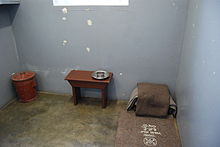The long way to freedom
The Long Walk to Freedom is the German title of the autobiography ( Long Walk to Freedom ) first published in the USA and Great Britain in 1994 by Nelson Mandela , the anti- apartheid fighter imprisoned for decades , a symbol of the strongest freedom movement in South Africa , Nobel Peace Prize laureate and first black Presidents in South African History . The US journalist Richard Stengel wrote the final version based on a manuscript of Mandela smuggled out of prison in 1976 and interviews that Stengel conducted with Mandela from 1992 onwards.
content
Mandela describes in detail his childhood in the small village of Qunu in Transkei as the son of a Xhosa royal house, his training at school and university, the activity as a young lawyer in Johannesburg and the politicization that went with it. Furthermore, the activities in the African National Congress (ANC) and in its “armed arm”, the MK , for the liberation from the apartheid regime, the two political trials against him and others, his imprisonment, which lasted almost three decades, especially among the extreme stressful conditions on the prison island Robben Island in the Atlantic off Cape Town as inmate 46664 , as well as the talks held with Presidents Botha and de Klerk before his release about the renewed legality of the ANC and an end to apartheid from his point of view.
The book also includes Mandela's family situation, especially his first two marriages. Since the biography appeared four years before his third marriage, it is not mentioned. It ends with the first free and equal elections and the subsequent inauguration of Mandela as President on May 10, 1994.
History of origin
In late 1975, inmate Ahmed Kathrada suggested that Mandela write his autobiography. Mandela secretly wrote several hundred pages of the manuscript while in custody on Robben Island. He wrote 10 to 15 pages a night and took around three months. Several other inmates helped him with this. Ahmed Kathrada and Walter Sisulu acted as editors, Mac Maharaj and Laloo Chiba transcribed the manuscript in miniature so that it only required a tenth of the paper. The inmates hid the original manuscript by burying it in cocoa containers in the garden, using tools they had made themselves. The manuscript was found by prison staff during construction. Mandela, Kathrada and Sisulu, whose manuscripts appeared in the manuscript, were banned from studying for four years. The miniature copy was smuggled out by Maharaj when he was released in December 1976. A publication was planned for Mandela's 60th birthday in July 1978. The ANC exile leadership decided against it.
After Mandela's release in 1990, the book was written by the American journalist and later politician Richard Stengel on the basis of the first manuscript and interviews with Mandela. However, Stengel is not mentioned as an author or co-author.
Some pages have survived from the original Robben Island manuscript.
Preliminary work
In collaboration with Ruth First , Mandela had already published the Rivonia Trial , which appeared in London in 1965 with the title No Easy Walk to Freedom with prefaces by Ahmed Ben Bella and Oliver Tambo .
structure
- Part: A childhood in the country
- Part: Johannesburg
- Part: The birth of a freedom fighter
- Part: The fight is my life
- Part: Treason
- Part: The black Pimpernell
- Part: Rivonia
- Part: Robben Island: The Black Years
- Part: Robben Island: Growing Hope
- Part: Talking to the enemy
- Part: freedom
dedication
Mandela dedicated the book to his 6 children, 21 grandchildren and 3 great-grandchildren as well as expressly to all “comrades, friends and fellow South African citizens” whom he serves.
reception
Thomas Kerstan included the book in his canon for the 21st century in 2018 , a selection of works that he believes "everyone should know".
expenditure
- 1994: Long Walk to Freedom. Little, Brown & Company, London, ISBN 0316545856 .
- 1994: The long road to freedom. Translation Günter Panske . S. Fischer, Frankfurt am Main, ISBN 978-3-10-047404-9 .
Web links
- Hans Hielscher: “God's gift for our country” ( Memento from September 28, 2007 in the Internet Archive ), epilogue to the 2006 edition of Spiegel .
- Website with facsimiles of pages of the original manuscript of Mandela and the copy in miniature writing (English)
Individual evidence
- ↑ a b c d e f g Role revealed of Madiba's comrades in Long Walk to Freedom. nelsonmandela.org, accessed March 16, 2017
- ^ Mac Maharaj (ed.): Reflections in prison. Zebra, Cape Town 2001, ISBN 1868723542 , p. Xi. Excerpts from books.google.de
- ^ Mac Maharaj (ed.): Reflections in prison. Zebra, Cape Town 2001, ISBN 1868723542 , p. Xii. Excerpts from books.google.de
- ^ Bibliographic entry in the catalog of the National Library of Australia . on catalogue.nla.gov.au (English)
- ↑ After the mirror -Issue 2006
- ↑ Th. Kerstan: What our children need to know. A canon for the 21st century. Hamburg 2018. p. 11, 183–185.
